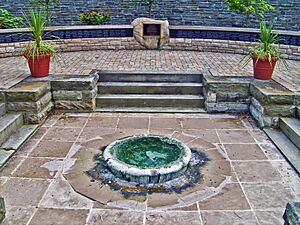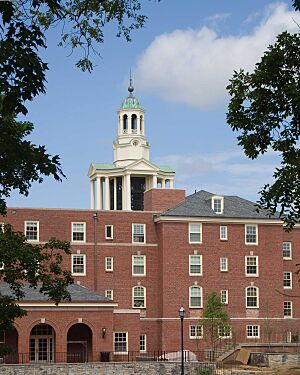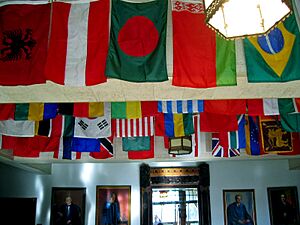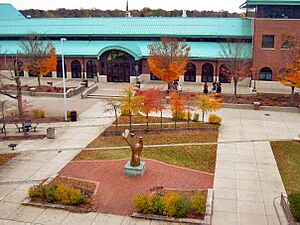Ohio Wesleyan University facts for kids
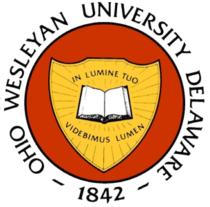 |
|
| Motto | In lumine tuo videbimus lumen (Latin) |
|---|---|
|
Motto in English
|
In Your Light We Shall See the Light |
| Type | Private liberal arts college |
| Established | September 1842 |
|
Religious affiliation
|
United Methodist Church |
|
Academic affiliations
|
|
| Endowment | $236.3 million (2020) |
| President | Matthew vandenBerg |
|
Administrative staff
|
200 |
| Undergraduates | 1,600 |
| Location |
,
U.S.
|
| Campus | Suburban, 200 acres (81 ha) |
| Colors | Red Black |
| Nickname | Battling Bishops |
|
Sporting affiliations
|
NCAA Division III – NCAC |
| Mascot | The Battling Bishop |
 |
|
Ohio Wesleyan University, also known as OWU, is a private liberal arts college in Delaware, Ohio. It was started in 1842 by Methodist leaders and local residents. The university is part of the Ohio Five, a group of similar colleges in the state.
The campus is about 200 acres (81 ha) and is located 27 miles north of Columbus, Ohio. It includes classrooms, student housing, the Perkins Observatory, and the Kraus Wilderness Preserve.
Contents
History of the University
How it all started (1841–1855)
In 1841, two Ohio residents, Adam Poe and Charles Elliott, wanted to create a top-quality university. They bought a former hotel that was famous for its Sulphur Spring. Local people helped raise the money for the purchase.
The university was named after John Wesley, the founder of Methodism. It officially opened on November 13, 1844, for male students. The school's first president, Edward Thomson, said the university was created because of the generosity of the local people. This spirit of generosity also led the university to strongly oppose slavery in the 1850s.
A time of growth (1855–1930)
In the mid-1800s, Ohio Wesleyan worked hard to attract more students and add new subjects to study. In 1855, Sturges Hall was built as the first library. In 1877, the Ohio Wesleyan Female College, which had opened in 1853, joined the university, allowing women to attend.
By the late 1800s, the university had added a School of Music, a School of Fine Arts, and a Business School. Many new buildings were constructed, including University Hall and Slocum Library. The school also created new departments for subjects like physics, zoology, history, and economics.
In 1906, Edwards Gymnasium was built. In 1909, the school's honor society, Phi Beta Kappa, started a chapter on campus. This is the oldest honor society for college students in the United States.
During the 1920s, the university made some changes. It closed its business school and its preparatory school (a school for students getting ready for college). It also built more buildings, like Selby Stadium and Perkins Observatory.
New classes and changes (1930–1984)
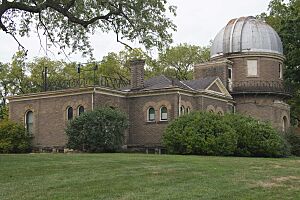
During the Great Depression in the 1930s, the university faced money problems because fewer students enrolled and donations decreased. The school changed its classes to focus more on subjects like business, social sciences, and English.
In 1946, Ohio Wesleyan created a new curriculum that required students to take classes in both sciences and humanities. In the 1960s, the school added a Women's Studies Program and an International Business major.
In the 1970s, students became more involved in how the university was run. They successfully protested to have the ROTC program removed from campus. They also asked to be part of meetings where important decisions were made.
The university today (1984–present)
In 1985, President David Warren worked to improve the school's reputation and attract more students. The university also became known for its strong science programs.
The Ohio Wesleyan sports teams, known as the Battling Bishops, have won several national championships. These include men's basketball in 1988 and men's and women's soccer in multiple years.
The university has continued to build and improve its campus. The Hamilton-Williams Campus Center opened in 1991. The Schimmel/Conrades Science Center opened in 2004, and the Meek Aquatics Center opened in 2011. In 2019, the university announced a $60 million project to update student housing.
Campus Life and Buildings
The Ohio Wesleyan campus is located next to the downtown area of Delaware, Ohio. A main street, Sandusky Street, divides the campus. Most of the academic buildings are on the east side, while student housing and administrative buildings are on the west side.
Off-campus places
OWU has several facilities that are not on the main campus. These include:
- The Perkins Observatory: This observatory has the second-largest telescope in Ohio.
- The Strand Theatre: A historic theater in downtown Delaware that the university helps operate.
- The Kraus Wilderness Preserve: A nature preserve for students to study the environment.
The university also has programs that let students study and work in other cities. Students can spend a semester in Washington, D.C., Philadelphia, or New York City to gain real-world experience.
Learning at OWU
What it's like to study here
Ohio Wesleyan is a member of the Five Colleges of Ohio, a group of top liberal arts colleges in the state. The university is known for having a student body that is interested in social issues.
The student-to-faculty ratio is 11 to 1, which means classes are small. Most classes have fewer than 20 students. This allows students to get to know their professors well. All classes are taught by professors, not teaching assistants.
The university works to make sure all students feel welcome. It has policies to support students from different backgrounds, including LGBT students. About 18% of students receive Federal Pell Grants, which help students from lower-income families attend college.
What you can study
Students at Ohio Wesleyan can choose from nearly 90 different majors. When they graduate, they can earn a Bachelor of Arts, Bachelor of Science, Bachelor of Fine Arts, or Bachelor of Music degree.
Some of the most popular majors in 2021 were:
- Zoology/Animal Biology
- Psychology
- Sports and Physical Education
- Business Administration
- History
- Political Science
A focus on the world
Ohio Wesleyan has a long history of being connected to the world. In 1879, an OWU graduate founded a women's college in Nagasaki, Japan. In 1899, another graduate opened a school in Zimbabwe that later became Africa University.
Today, the university has many international students. Flags from over 60 countries are displayed in University Hall to celebrate this diversity. OWU also has exchange programs that allow students to study in other countries, such as Japan and Spain.
Student Life
Clubs and activities
Ohio Wesleyan has over 95 student clubs. These include groups for interests like chess, finance, and singing. There are two a cappella groups on campus, "The OWtsiders" and "Pitch Black." There is also an improvisational comedy group called "The Babbling Bishops."
Students can also get involved in groups that focus on social issues or student government. The "PRIDE" organization supports LGBT students on campus.
About one-third of students are part of Greek life. These groups participate in community service and social events.
The university has a student-run newspaper called The Transcript, which is the oldest independent college newspaper in the country. There is also a student radio station, OWU Radio.
Student activism
Activism, or working to create social change, has always been important at Ohio Wesleyan. The university's first president was against slavery. An alumnus named Branch Rickey helped break the color barrier in baseball by signing Jackie Robinson.
Today, students are involved in many groups that focus on politics and social justice. These include groups like the College Democrats and the Black Student Union.
Traditions
Ohio Wesleyan has many fun traditions.
- Monnett Weekend: An event that started in 1896 for female students and alumni. It includes a parade, dancing, and a carnival.
- Mock Convention: Held every four years during a presidential election. Students learn about the election process and pretend to nominate a candidate.
- President's Ball: A formal dance held in December.
- The Rock: A large rock on campus that students are always repainting with messages and art.
Sports at OWU
Ohio Wesleyan's sports teams are called the Battling Bishops. They compete in the NCAA Division III as part of the North Coast Athletic Conference (NCAC). The school colors are red and black.
The university has 25 varsity sports teams for men and women. The men's soccer team and women's soccer team have been very successful, winning five national championships between them. The men's basketball team also won a national championship in 1988.
The nickname The Battling Bishops was chosen in 1925. The mascot is a bishop in a red robe. Before 1925, the teams were called "The Red and Black" or "The Methodists."
Ohio Wesleyan has friendly rivalries with other colleges in its conference, especially Denison University in lacrosse and Kenyon College in soccer.
Famous People from OWU
Many Ohio Wesleyan graduates have become famous in different fields.
In science and education
- Frank Sherwood Rowland (1948) won the 1995 Nobel Prize in Chemistry for his work on the Earth's ozone layer.
- Ezra Vogel (1950) was a famous expert on China and Japan at Harvard University.
In government and politics
- Charles Fairbanks (1872) was the 26th Vice-President of the United States.
- Arthur Flemming (1927) was the Secretary of Health, Education, and Welfare and received two Presidential Medals of Freedom for his work on civil rights.
- Lucy Webb Hayes (1853) was the wife of U.S. President Rutherford B. Hayes. She was the first president's wife to be called the First Lady and the first to have a college degree.
In journalism and the arts
- Frank Stanton (1930) was the president of CBS and a strong supporter of broadcast journalism.
- Wendie Malick (1972) is an actress known for her roles in TV shows like Just Shoot Me! and "Hot in Cleveland."
- Clark Gregg (1984) is an actor known for playing Agent Phil Coulson in the Marvel Cinematic Universe.
In sports and social justice
- Branch Rickey (1904) was a baseball executive who signed Jackie Robinson, the first African-American player in Major League Baseball.
- Rev. Norman Vincent Peale (1920) was a famous minister and author of the book The Power of Positive Thinking.
See also
 In Spanish: Universidad Wesleyana de Ohio para niños
In Spanish: Universidad Wesleyana de Ohio para niños


